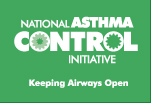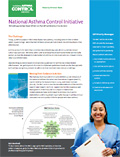Employers, Employees, and Worksites
Work-related asthma is a bigger problem than you may think.
Occupational asthma, also called work-related asthma, is the most common occupational lung disease in the United States. It affects about 15% of adults with asthma, although estimates vary. It can cause wheezing, chest tightness, shortness of breath, and coughing. Symptoms may emerge hours after exposure to harmful substances or even months or years later.
Occupational asthma is costly for everyone. It reduces productivity and quality of life and increases costs to employees, families, businesses, and taxpayers. Some employees become too disabled to work, while others must change jobs to avoid the substance that caused their asthma.
Unless occupational asthma is caught and managed early, it is likely to continue and get worse. That’s why the Guidelines for the Diagnosis and Management of Asthma (EPR-3) recommends that clinicians ask patients who have asthma about possible occupational exposures.
Who is at risk for occupational asthma?
Workers in a wide range of worksites—from bakeries to hospitals—are at risk. Occupational asthma results from exposure to allergens or irritants on the job. These exposures can lead to new cases of asthma (new-onset asthma) or worsen existing asthma (work-aggravated asthma).
More than 250 substances are known or believed to cause or exacerbate work-related asthma. These substances include many chemicals used in manufacturing; paints; cleaning products; dusts from wood, grain, and flour; latex gloves; certain molds; animals; and insects. In some cases, cigarette smoking may increase the risk of developing occupational asthma.
Occupational asthma can be controlled
There are three main approaches to controlling occupational asthma in the worksite:
- Prevent the disease by reducing or eliminating environmental allergens and irritants.
- Detect the disease early, even before symptoms appear, by using surveillance measures.
- Avoid worsening symptoms by preventing exposure or using something less harmful.
Prevention is everyone’s responsibility
Together, employers and employees can create safe, supportive worksites that minimize exposure to allergens and irritants and reduce the impact of occupational asthma on health and productivity. Use the tips and resources below to help control asthma in the workplace.
Employers
- Adhere to federal health and safety guidelines. The Occupational Safety and Health Act (OSHA) of 1970 requires employers to provide workplaces free from recognized hazards. About half of U.S. states and territories also set their own standards under OSHA-approved state plans.
- Institute programs to prevent occupational asthma by reducing exposure to allergens and irritants through elimination or substitution. Personal respiratory protective equipment can reduce the occurrence of occupational asthma but not completely prevent it.
- Establish a surveillance program to identify affected workers early. Look for symptoms of asthma. Lung function tests (spirometry) and skin tests can help confirm the disease.
- Train workers on potential workplace hazards, including precautions to take and mechanisms for reporting hazards or problems.
- Eliminate smoking in the workplace. Offer benefits and smoking cessation programs to encourage employees to quit.
Employees
- Avoid exposure to known environmental allergens or irritants.
- Get help from a physician for breathing problems before they become permanent.
- Report respiratory symptoms immediately as well as breakdowns in ventilation and other protective equipment to your employer. Your co-workers also may be at risk.
- Take care of your asthma. See your physician regularly, take medications as directed, and avoid environmental exposures that worsen your asthma.
- Avoid tobacco smoke. If you smoke, get help to quit.




















 Twitter
Twitter
 Facebook
Facebook YouTube
YouTube